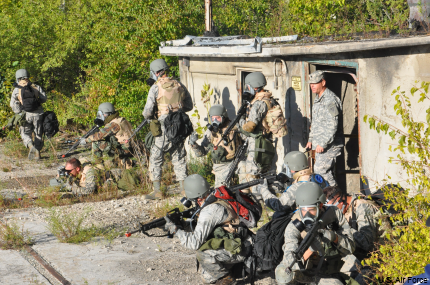Air Force scientists take the field as Tech Warriors
The training exercise lets those who develop new battlefield technologies experience life as a warfighter.

Participants searching an abandoned building for a weapons cache exit after a smoke bomb simulating mustard gas was released.
Scientists working on new technologies for warfighters can listen to commanders, talk with soldiers and assess feedback forms after tests of prototypes. Or, they can live like those warfighters.
That’s the idea behind the Air Force Research Laboratory’s Tech Warrior exercise, the latest edition of which took place earlier this month at Wright State University's National Center for Medical Readiness (NCMR) in Fairborn, Ohio. Research scientists and engineers left the familiar confines of their labs and spent eight days setting up and operating a base camp in as realistic an environment as AFRL could provide.
They went on dismounted patrols, searched tunnels for caches of weapons (and evacuated after a smoke bomb simulating mustard gas was set off), delivered aid to the wounded (some of them mannequins) and carried out other tasks involving base defense, tactical vehicle driving and land navigation. And, this being 2015, they also worked in the cyber domain and with new technologies such as bio-feedback patches and augmented reality.
"The participants arrived here as engineers and scientists and I hope that they left as technological warriors,” Lt. Col. David Shahady, who has been the commander of Tech Warrior since 2011, said, adding “and always look at new technology from a warrior's perspective."
Divided into a warrior squadron and a technology squadron, the 200 participants—both military and civilian—worked with a variety of warfighting technologies during the week, leading up to a 48-hour exercise during which they tested their recently learned skills in an increasingly realistic environment, AFRL said.
Among the new technologies tested: the BioStampRC Wearable Sensing Platform, which uses a patch that provides human performance monitoring and data for biomedical research; an array of video cameras that collected intelligence from around the camp, which analysts then used to provide the camp’s defenders with real-time information; and augmented-reality glasses that told the wearers where they were in relation to threats.
Ultimately, the goal of Tech Warrior is to get better technologies into the hands of warfighters by letting the people who develop those technologies experience a battlefield environment through the eyes of the warfighters.
As Maj. Jared Ekholm, Warrior Squadron commander, put it: "It's been a great opportunity to have our scientists and engineers and some of the junior people of AFRL come out and get some real world operational experience and take those experiences back and make sure the technologies that we're developing better fit the needs of our warfighters."



